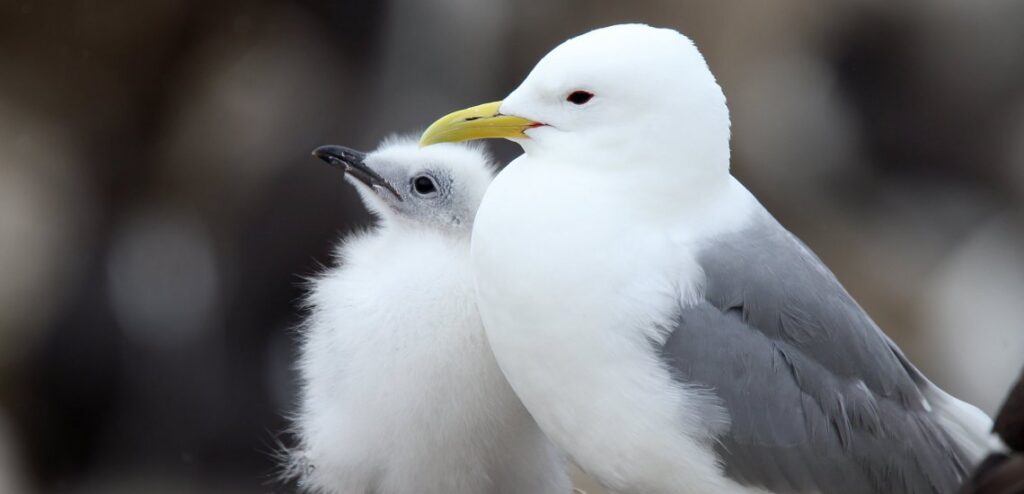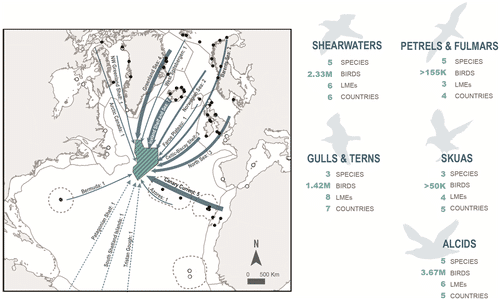Seabird of the month: Black-legged Kittiwake (Rissa tridactyla)

Black-legged Kittiwakes have a white head and body, a grey back grey and black wings, black legs, and a yellow bill. Their diet is rich in carotenes and vitamin A, turning the base of their beaks into a striking, intense red colour.
by Antonio Vulcano
IUCN status: Vulnerable (Global)
Global population: 3,460,000 – 4,410,000 mature individuals
Description:
Wingspan: 93 – 105 cm
Life span: between 12 and 20 years, long-lived birds as old as 28 years have been reported as well
Distinct features: Black-legged Kittiwakes have a white head and body, a grey back grey and black wings, black legs, and a yellow bill. Their diet is rich in carotenes and vitamin A, turning the base of their beaks into a striking, intense red colour.
Main prey: Kittiwakes are pelagic piscivorous birds, meaning that they only eat fish. They mainly eat small, pelagic shoaling fish, and sometimes invertebrates such as copepods, polychaete, and squids. Kittiwakes will also prey on fish offal and discards around fishing boats. This can be an important food source when their preferred prey is less abundant.
Breeding
Monogamous pairs nest in colonies, usually in large numbers, on vertical, rocky cliffs by the sea. Breeding season starts in mid-June and ends in August. Females usually lay one or two eggs, and both parents share incubation duties. The egg hatches after one month, and the chick fledges between 33 and 54 days after hatching.
Chicks are born as semi-precocial, meaning that they are relatively mobile and mature after hatching, but are not able to properly thermoregulate during their first week. The first-born chick may kill its sibling to avoid food competition. Chicks may come back to the nest at night for several weeks after hatching, before eventually following the adults at sea where they spend the winter.
After breeding, these birds move out into the Atlantic where they spend the winter.
Population distribution
This seabird mainly breeds in Britain, Ireland, and Iceland. The largest colonies are found along the North Sea coasts of the United Kingdom, around Orkney and Shetland islands, off north-west Scotland, eastern Iceland, the north of Norway, and the Faroe Islands. The number of individuals in many of those colonies has significantly decreased in the last two decades.
In general, the population of the Black-legged Kittiwake is in decline over its entire breeding range and is in some places nosediving. Human activities impact breeding kittiwakes. With climate change and overfishing driving their main prey, sand eels and capelins, further North, parents are unable to find enough fish to feed their chicks. To survive, they must either switch to different prey or try to follow their preferred food further North. But neither option is ideal, and both will impact the breeding success of these Kittiwakes that are already in decline. By changing their diet, or having to travel further for it, the birds exert more energy for the same amount of food, until they cannot sustain the needs of their chicks any longer, until they ultimately starve to death.
Main threats
- Overfishing
- Climate change
- Bycatch
BirdLife and the Black-legged Kittiwake
An amazing seabird-tracking collaboration led by BirdLife has revealed a new major seabird hotspot in the North Atlantic high seas, used by up to 5 million birds! Among 21 species from 56 colonies within 16 different countries, this area is also used by kittiwakes. The protection of this area where kittiwakes winter is crucial to enhance their breeding success.
To protect these seabirds, it is crucial that we do more monitoring of the other threats these seabirds face in their wintering grounds, such as overfishing, marine pollution and bycatch to guarantee kittiwakes have good quality wintering areas. This is essential to stop them from heading towards extinction.
This newly designated Marine Protected Area, known as NACES (North Atlantic Current and Evlanov Seamount), is in the high seas, and beyond national jurisdiction.

Fun facts
The name kittiwake is derived from its call, a shrill ‘kittee-wa-aaake, kitte-wa-aaake’.
With its graceful flight, the bird is the most pelagic of the gull and tern families, almost exclusively found at sea, except during their breeding period. To seduce the female, male kittiwakes will feed them at their nest site. They will also jerk their head up and down, gradually opening their bill, to attract a female.
Check the previous seabirds of the month:
Cory’s shearwater (Calonectris borealis)
Scopoli’s Shearwater (Calonectris diomedea)
Northern Gannet (Morus bassanus)
Arctic Loon/Black-throated Diver (Gavia arctica)
Image credit: Black-legged Kittiwake – Rissa tridactyla ©Tony Mills
Stay up to date
Sign up to receive the latest bird conservation news. You’ll also receive updates about our projects, science and other ways to get involved including fundraising.
Thank you for your support, we are committed to protecting your personal information and privacy. For more information on how we use your data, please see our Privacy Policy. You can unsubscribe from emails at any time by using the link in the footer of any email from us.

